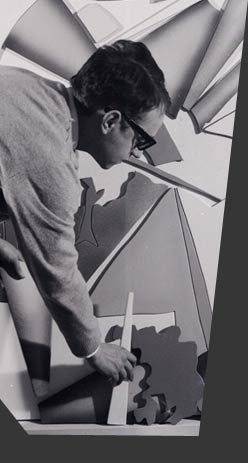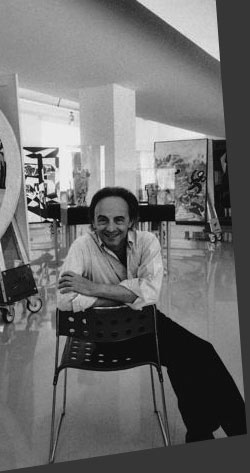Vittorio Orsenigo
UGO NESPOLO AND HIS WISE ADRENALIN
A figure came on from Citizen Kane's black-and-white interiors, just after the impending shadow of Orson Wells, who made scream the apocalyptic siren of the invading martians using old hertzian waves to create catastrophic alterations in the cardiac rhythm of the audience. At first sight you may take it for the protagonist of a lemon-guaranteed saga where the assumptions of our century reasonably, take the place of the fabulous identifications in Brothers Grimm's tales. Who felt this kind of doubtless emotion knows very well what we are referring to: the name of that creature is Ugo Nespolo.
He walked across a gargantuan slice of the most loved 20th century, shooting it from each part but without producing the damages of a thunderbolt. On the contrary, he turned his terrible energy into the applicated forms of a cultural knowledge that spreads itself everywhere without obstacles. What is his mean of transport, it's difficult to understand; sometimes that vehicle, for its mystery and its rush, seems to be a limousine; sometimes, it seems a reduced-scale model of a big spindle, unspoiled in its musical and artisanal grace. But there are some critics who maintain the absolute idea that the vehicle used by Nespolo to go across Surrealism and Dadaism was built in order to substain it and, at the same time, rise against it.
They consider this possibility the nature of the crystalline lens, without put their glasses on (glasses that are useful in Chatwin's Patagony as good as in the tibetan ShangriLa revisited by Lawrence Osborne in times of Olympic Games). But it's not enough: these scholars, studying his unusual mean of transportation, keep on thinking that he could sail to the future as good as to the past, and that he could pick up Zola from Queneau station, or Catullo an Petronio from Rimbaud station.
From these considerations came the idea hat each epoch can be translated int "contemporaneity, and in a better way than old latin verses adapted by Iosif Brodskij. Just a pure and chaste Mycenaean Venus, both erotic and brightening in each part of her body. If from word's toponyms we pass to painting's ones, we don't mean any arm; it's just as opening the door at the end of a passage.
There is no difference: when Ugo Nespolo draws or paints, he imagines beautiful theatre scenes and costumes, avoiding shameless butts and lifeless behaviours with his torero's step. He blends sounds, lights and rhythms by directing on the stage faces, legs, arms and actors' senses, plunged in the water scenography of Torre del Lago for Puccini's music. What is, really, Ugo Nespolo's provocation? He embodies cultural moments, both near and far in time, focuses and erases the "sailing exploit" by the ritualized holiness of art. It doesn't mean the Assumption to Heaven of oceanic gods through cannibal acts that ethnologists and morgue assistants always try to put out of game (the two of them feeling lost) and concerned by Recognition and Reduction of the whole to elementary particles. Just a controlled discharge remains on the field, really rigorous, of wise adrenalin that draws a direction and emphasizes different memories of taste, never in the present time.
The adrenalin they'll never achieve will be substituted by an evolution of the present moment mirror of market's developments and the current costume of "gulping down" it.
They can't use the eclecticism of a shining artist as Ugo Nespolo like a banal "service station". Because there are cars that in their stomach-tank conceal energetic charges of petrol, diesel or alcohol coming from Smyrna's figs, and many others cars that go to service stations with different buildings, but, at least, with the same nature.
(From the book: Nespolo Antologia, Galleria dâArte Orler, Schola del'Arte del Tiraoro e Battioro, Campo San Stae, Venezia, 2008, Techne Editore, Venezia)



